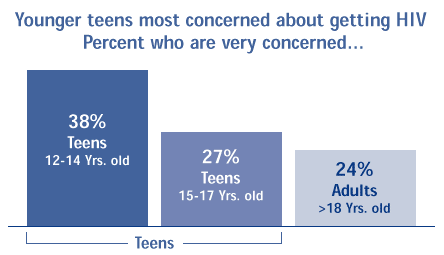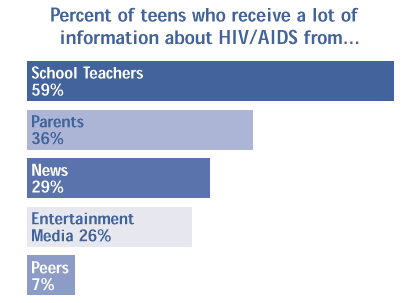Fact Sheet: World AIDS Day 1998 – Youth And AIDS
World AIDS Day 1998: An Update On Youth And HIV
New Survey Data On Teens
In November 1998, the Kaiser Family Foundation conducted a survey of 517 teens between the ages of 12 and 17.* The results…
What Teens say about HIV/AIDS:
- Teens express high rates of PERSONAL concern about becoming infected with HIV, higher than adults in the general population. A third are “very concerned” (32%), and 22% are “somewhat concerned” (as compared to 24% and 17% among US adults, respectively).
- While rates of personal concern are similar for male and female teens, younger teens, aged 12-14, express higher rates of concern when compared to 15-17 year olds (38% vs. 27%).
- Over a third (35%) of all teens feel that AIDS is a “very serious problem” for people they know.
- Even before leaving their teens, almost one in five young Americans (18%) report personally knowing someone who is living with, or has died from, HIV/AIDS.

Where Teens Get Information about HIV/AIDS:
- Teens say they receive “a lot” of HIV/AIDS information from: School/teachers (59%), Parents (36%), News (29%), and Entertainment media (26%). Peers are not as significant a source of “a lot” of HIV information (7%).
- Teen girls are more likely than boys to cite their parents as a source of “a lot” of information about HIV/AIDS (39% vs. 33%).
- Younger teens, aged 12 to 14, are more likely to cite their parents as a source of “a lot” of information about HIV/AIDS (40%) than older teens aged 15 to 17 (32%), while older teens are more likely to cite school as source of “a lot” of information (63% vs. 55%).

HIV and Youth: The Facts
- Every hour, two Americans under the age of 20 become infected with HIV.1
- Each year, as many as 50% of new HIV infections in the US may be among people under the age of 25.2
- About 25% of all people now living with HIV became infected with HIV when they were teenagers.3
- The numbers of adolescent AIDS cases in the US have increased more than seven-fold over the past decade.4
- Young people are increasingly getting HIV through heterosexual sex, especially young women and minority youth.5
- A recent study found that almost two thirds (63%) of 13-24 year olds with HIV are African American.6
- Young women, aged 13-19, accounted for about half (49%) of all new AIDS cases in 1997 within this age group.7
What are young people doing that puts them at risk for HIV?
They are sexually active… A recent nationwide study of high school students found that:8
- Almost two thirds (61%) have had sexual intercourse by the 12th grade.
- One fifth (21%) of 12th graders have had four or more sex partners.
- Almost half (46%) of 12th graders are currently sexually active as are one quarter (24%) of all 9th graders.
- One quarter (25%) of all high school students report using alcohol or drugs during sex, including 33% of 9th graders.
But, young people ARE protecting themselves and engaging in less sexually risky behavior:9
- Overall, high school students are less sexually active today, a decrease of 11% since 1991.
- Among sexually active high school students, condom use has increased by 23% since 1991.
- Over half (57%) of sexually active high school students in 1997 reported they used condoms the last time they had sexual intercourse.
- African American students (64%) were significantly more likely than White or Hispanic students (56% and 48% respectively) to report condom use.
- However, while sexual activity among high school students appears to be decreasing over time, this is NOT the case for female students. Similarly, while male students have fewer sex partners compared to a few years ago, female students do not.
Why do young people put themselves at risk for HIV?
Young people’s assessment of risk and risk taking is based on a complex web of assumptions, perceived knowledge, and social dynamics. Key factors which influence unsafe sex behavior include:10
- “Trusting” a partner not to put them at risk
- “Judging” low HIV/STD risk based on a partner’s “clean” appearance
- “Knowing” their partner’s sexual history
- Perceiving “monogamy” of partner in a relationship
- Thinking that they or their partner are not in a “high risk” group
- Using alcohol or drugs before and/or during sex
- Being in a relationship with a power imbalance, e.g., differences in age or sexual experience
- Having peers who are less concerned about HIV/AIDS
What young people are doing about HIV
Young people are involved in many HIV/AIDS related activities in their communities, schools, and families, including:
- Participating and organizing peer education programs
- Educating their communities through outreach
- Volunteering their skills and time to help people with HIV/AIDS
- Fundraising for HIV/AIDS services and programs
- Advocating for people with HIV through community activism
- Providing personal support for their friends and family members affected by HIV
- Doing creative work – arts, films, websites, writing – about HIV/AIDS
- Actively planning for the future and articulating goals and dreams
- Having kids of their own and giving them positive messages
Footnotes:
1. Youth & HIV/AIDS: An American Agenda. A report to the President prepared by the Office of National AIDS Policy, March 1996.
2. Centers for Disease Control and Prevention, CDC Facts: Adolescents and HIV/AIDS, March 1998.
3. http://hivinsite.ucsf.edu, Kirby, Douglas, The AIDS Knowledge Base: HIV Prevention Among Adolescents, November 1997.
4. Centers for Disease Control and Prevention, CDC Facts: Adolescents and HIV/AIDS, March 1998; Centers for Disease Control and Prevention, HIV/AIDS Surveillance Report, 1997 Year-end edition, Vol. 9, No.2.
5. Rosenberg, S. and R. Biggar, “Trends in HIV Incidence Among Young Adults in the United States”, Journal of the American Medical Association, Vol. 279, pp. 1894-1899, June 1998.
6. Centers for Disease Control and Prevention, “Diagnosis and Reporting of HIV and AIDS in States with Integrated HIV and AIDS Surveillance – United States, January 1994-June 1997”, Morbidity and Mortality Weekly Report, Vol. 47, No. 15, April 1998.
7. Centers for Disease Control and Prevention, HIV/AIDS Surveillance Report, 1997 Year-end edition, Vol. 9, No.2.
8. Centers for Disease Control and Prevention, “Youth Risk Behavior Surveillance – United States, 1997”, Morbidity and Mortality Weekly Report, Surveillance Summary, Vol. 47, No.SS-3, August 1998.
9. Centers for Disease Control and Prevention, “Youth Risk Behavior Surveillance – United States, 1997”, Morbidity and Mortality Weekly Report, Surveillance Summary, Vol. 47, No.SS-3, August 1998; Centers for Disease Control and Prevention, “Trends in Sexual Risk Behaviors Among High School Students – United States, 1991-1997”, Morbidity and Mortality Weekly Report, Vol. 47, No. 36, September 1998.
10. Michaels Opinion Research, Center for AIDS Prevention Studies, and the Harvard AIDS Institute, Listen to What America’s Kids Are Saying: A Qualitative Research Study.
* This nationally representative telephone survey has a margin of error of +/- 4 percentage points.
Additional Resources:
For, It’s Your (Sex) Life, a free guide on safer sex, call 1-888-BE SAFE1 For, Talking With Kids About Tough Issues, a free booklet for parents, call 1-800-CHILD 44
